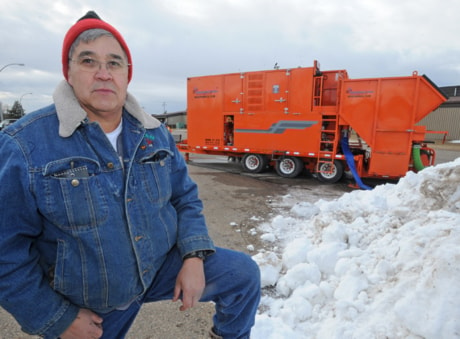Larry Cunningham arranged for tonnes of scrapings from Edmonton ice rinks to be hauled to the city’s downtown in October. Sand and dirt were added to the snowy piles, and the mixture dumped into the giant hopper of a snow melt machine.
Inside, a flame nearly three metres long and a metre in diameter quickly dispatched the frozen material. The resulting water drained into the municipal storm sewer system and the solid residue was recovered by mechanically tipping the tank.
Cunningham, who operates Red Deer-based Snow Removal Systems Canada Inc., thinks the potential for this technology is as deep as the white mountains that form in snow-bound cities every winter. Particularly for bigger urban centres, it’s an alternative to hauling snow great distances to dump sites.
Other potential customers include operators of parking lots, where accumulated snow can consume valuable space; and airports, where trucks travelling on and off the property create security concerns.
Portable snow melt machines have been around for decades, said Cunningham, with New York City employing a fleet. But he thinks the technology is beginning to displace traditional haul-and-dump systems.
“I think it’s great to get into it at this time.”
Cunningham made the leap early this year.
A petroleum engineering technician with a third-class steam engineer ticket, he’d worked internationally in the oil industry for more than 35 years. Most recently, Cunningham had started an oilfield pumping heating company at Hinton.
“I was going to semi-retire with one truck,” he said, explaining that he wanted to spend more time at his Red Deer home.
Instead, he expanded the business and even developed the largest oilfield water heater in Canada.
“We grew it to 40 people and 10 trucks in three years.”
After selling the business last fall, Cunningham came across a magazine article about snow melters. The technology seemed to dovetail nicely with his own expertise, so he contacted several North American manufacturers.
Ultimately, he invested in Snow Removal Systems Inc. — a Bellingham, Wash.-based company with a patented closed-loop melting system. Cunningham obtained the rights to build snow melt machines with a capacity of up to 100 tonnes an hour, with the American company to manufacture bigger units.
Operating as Snow Removal Systems Canada, Cunningham retained the basic process but redesigned the equipment. In fact, he’s built his first machines virtually from scratch — with most of the components fabricated in Saskatchewan and Alberta, and assembly occurring at NWP Industries Inc. in Innisfail.
The American and Canadian companies work closely together, sharing a sales network that now includes a dealer in Europe. Cunningham said Snow Removal Systems machines have a couple advantages over those produced by competitors.
One is the tipping mechanism he designed, which reduces labour and increases safety.
“A snow melter that’s going through 100 tonnes an hour of snow, probably has half a tonne to a tonne of gravel coming in with it,” he said.
Additionally, the flames in other snow melt machines contacts the snow — resulting in incomplete combustion and emissions that collect in the snow melt.
“Our flame doesn’t contact any steel until it’s completely combusted.”
In addition to his Edmonton demonstration, Cunningham has conducted a couple trials in Innisfail — including one for a major oil company interested in melting snow from gravel roads in the Fort McMurray area.
On the municipal front, the potential is probably greater on the eastern side of the continent where snow volumes are higher.
However, Cunningham doesn’t consider his Central Alberta location a disadvantage. In fact, with the recent downturn in the oilpatch he’s been able to take advantage of surplus manufacturing capacity here.
“I couldn’t have built here two years ago. I wouldn’t have got things done.”
He now has two full-time employees on staff and estimates that his company has created work for at least 50 people. He expected to have his second and third units operational early this month, with the stage set for assembly line production.
“I believe I could build 10 machines in 2010 on my own,” said Cunningham.
Beyond that, he’ll probably need to attract some venture capital and senior management.
His first three snow melt machines will probably end up costing $1.2 million to $1.3 million. Cunningham plans to sell them for $300,000 each, writing off the deficiency to development and marketing costs.
Similar snow melt machines produced by Snow Removal Systems Canada in the future will probably sell for about $450,000, he said.
Working 60 to 80 hours a week, Cunningham remains a long way from the semi-retired lifestyle he once coveted. But he’s passionate about what he’s doing, and now has something the oilpatch couldn’t give him.
“I’ve been at home and in my bed since February.”
hrichards@www.reddeeradvocate.com
